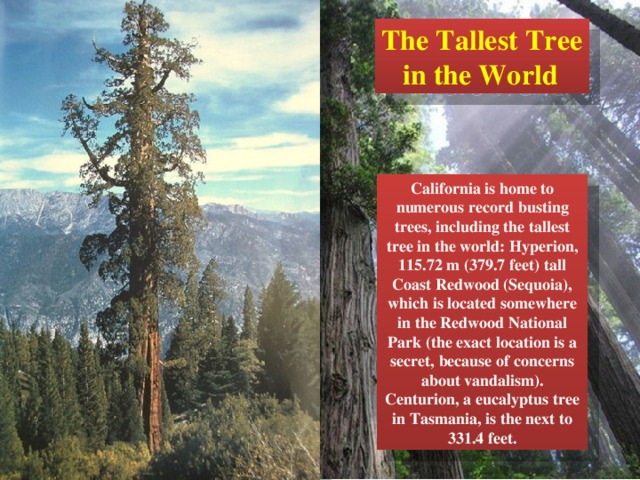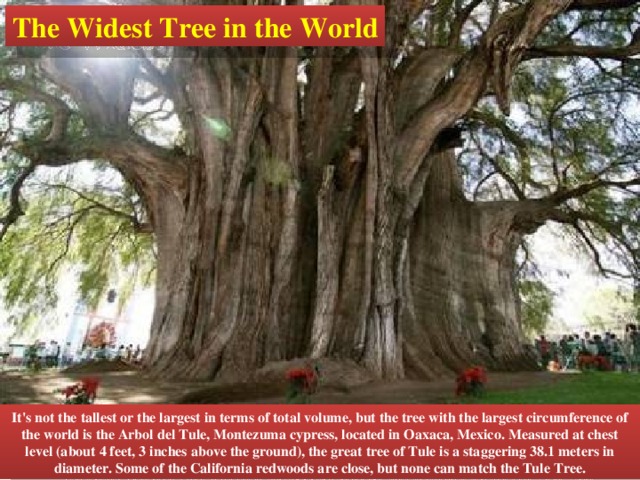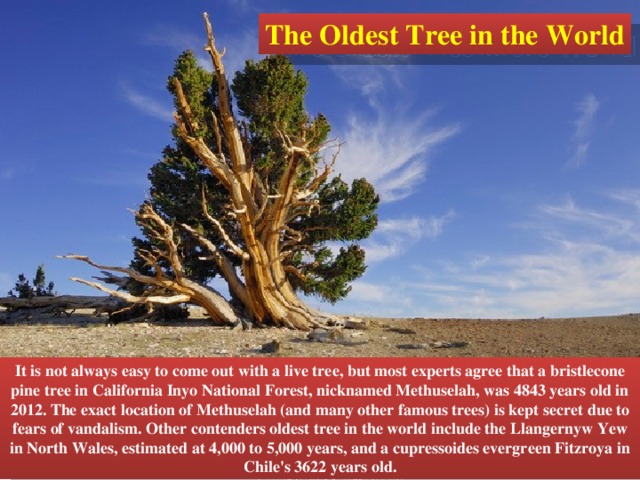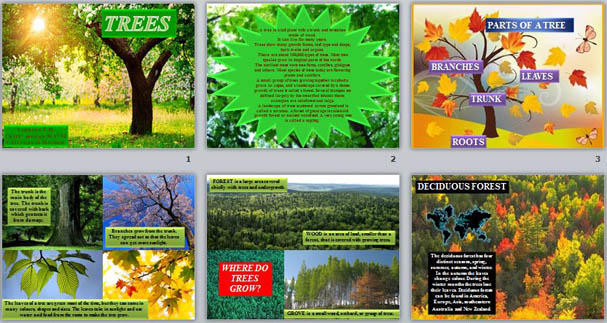
TREES
Теряева Т.П.
ГБОУ школа № 1794
САО города Москвы

A tree is a tall plant with a trunk and branches
made of wood.
It can live for many years.
Trees show many growth forms, leaf type and shape, bark traits and organs.
There are about 100,000 types of trees. Most tree species grow in tropical parts of the world.
The earliest trees were tree ferns, conifers, ginkgoes and others. Most species of trees today are flowering plants and conifers.
A small group of trees growing together is called a grove or copse, and a landscape covered by a dense growth of trees is called a forest. Several biotopes are defined largely by the trees that inhabit them; examples are rainforest and taiga.
A landscape of trees scattered across grassland is called a savanna. A forest of great age is called old growth forest or ancient woodland. A very young tree is called a sapling.

PARTS OF A TREE
BRANCHES
LEAVES
TRUNK
ROOTS

The trunk is the main body of the tree. The trunk is covered with bark which protects it from damage.
Branches grow from the trunk. They spread out so that the leaves can get more sunlight.
The leaves of a tree are green most of the time, but they can come in many colours, shapes and sizes. The leaves take in sunlight and use water and food from the roots to make the tree grow.

FOREST is a large area covered
chiefly with trees and undergrowth .
WOOD is an area of land, smaller than a forest, that is covered with growing trees.
WHERE DO
TREES
GROW?
GROVE is a small wood, orchard, or group of trees.

DECIDUOUS FOREST
The deciduous forest has four distinct seasons, spring, summer, autumn, and winter. In the autumn the leaves change colour. During the winter months the trees lose their leaves. Deciduous forests can be found in America, Europe, Asia, southeastern Australia and New Zealand .

The Coniferous forest is home to evergreen trees. Conifers have needles instead of broad leaves. They do not have flowers or fruits. In late winter or early spring they form cones.

TAIGA
TAIGA is an impassable forest in the north of Eurasia and North America. The taiga is located near the top of the world. The winters in the taiga are very cold with only snowfall. A lot of coniferous trees grow in the taiga.

THE AMASON RAINFOREST
A huge moist leaf forest covering a great swathe of the top of South America, the Amazon spreads into nine countries. Being the largest rainforest in the world the Amazon has great biodiversity. More than a third of all the world’s species live in the Amazon, a vast range of plants, more than two and a half million species of insects, 3000 kinds of fishes, 1,200 types of birds, 370 kinds of reptiles and 420 different mammal species.

TROPICAL AFRICA
On both sides of the equator - rainforests. More than 1,000 species of trees grow there. Lianas - up to 100 meters long. Huge ferns, bananas, palms and plenty of evergreen vegetation.
Savannas, and shrublands are spread over a large area of Africa with a vegetation made up of low shrubs and grasses. Acacia and baobab are common trees here.

ASH
ASH - a tree with silver-gray bark and compound leaves. The ash is widely distributed throughout north temperate regions where it can form forests.

BAOBAB
BAOBAB is a short tree with an enormously thick trunk and large edible fruit. It can live to a great age.
Baobab grows on the African continent, found in the hot, dry savannahs .

BEECH
BEECH - a large tree with smooth gray bark, glossy leaves, and hard, pale, fine-grained timber. Its fruit, the beechnut, is an important food for numerous wild birds and mammals.
BEECH NUT

BIRCH
CATKINS
BIRCH is a slender, fast-growing tree that has thin bark (often peeling) and bears catkins. Birch trees grow chiefly in north temperate regions.

CONIFERS
About 700 species of conifers can be found in almost all parts of the world. Typical examples include cedars, cypresses, firs, larches, pines, spruces, and redwoods . Conifers are of great economic value, and their wood is mainly used for timber and paper making.
LARCHES are conifers. They grow on the northern hemisphere. Unlike other conifers, larches lose their leaves during autumn and winter.
LEBANON CEDAR
CYPRESS –an evergreen coniferous tree with small, rounded, woody cones and flattened shoots bearing small, scalelike leaves

CONES
NEEDLES
CONIFERS
SPRUCE (FIR TREE)
PINE

Giant sequoias or California redwoods are nature’s skyscrapers. These enormous trees exist primarily in Northern California. Giant sequoias can grow to about 30 feet (9 meters) in diameter and more than 250 feet (76 meters) tall.
Giant Redwood (Sequoia) Trees

EUCALYPTUS
Eucalyptus is a fast-growing evergreen Australian tree that has been widely introduced elsewhere. It is valued for its timber, oil, gum, and resin, and as an ornamental tree.
Koalas eat only eucalyptus leaves

HORSE CHESTNUT
HORSE CHESTNUT - a deciduous tree with large leaves of five leaflets, conspicuous sticky winter buds, and upright conical clusters of white, pink, or red flowers. Unrelated to true chestnuts, the horse chestnut bears unpalatable nuts enclosed in fleshy, thorny husks.

ACORNS
OAK
OAK is a tree that bears acorns as fruit, and has lobed deciduous leaves. Oaks are common in north temperate forests.

LINDEN
LINDEN is a deciduous tree with heart-shaped leaves and fragrant yellowish blossoms, native to north temperate regions. The pale soft timber is used for carving and furniture. Linden is a popular medicinal plant.

OLIVE TREE
Olive is a small oval fruit with a hard pit and bitter flesh, green when unripe and brownish black when ripe, used as food and as a source of oil.
OLIVE TREE is the widely cultivated evergreen tree that yields the olive, native to warm regions of the Old World.

PALM TREE
PALM is a tropicfl evergreen tree with a crown of long feathered leaves growing from the top of its trunk.

ROWAN
Rowan (Mountain Ash) is a fast-growing tree, characterised by its brilliant red berries at the end of summer.

WILLOW
WILLOW is a tree of temperate climates that typically has narrow leaves, bears catkins, and grows near water. Its pliant branches yield osiers for basketry, and its wood has various uses.

The Largest Tree
in the World
The Largest Tree in the World, the giant sequoia known as General Sherman. It is a monster of a tree - at 52,508 cubic feet, it's the world's largest tree, and perhaps the world's largest living thing. General Sherman is located in California's Sequoia National Park and is one of the park's premier attractions.

The Tallest Tree
in the World
California is home to numerous record busting trees, including the tallest tree in the world: Hyperion, 115.72 m (379.7 feet) tall Coast Redwood (Sequoia), which is located somewhere in the Redwood National Park (the exact location is a secret, because of concerns about vandalism). Centurion, a eucalyptus tree in Tasmania, is the next to 331.4 feet.

The Widest Tree in the World
It's not the tallest or the largest in terms of total volume, but the tree with the largest circumference of the world is the Arbol del Tule, Montezuma cypress, located in Oaxaca, Mexico. Measured at chest level (about 4 feet, 3 inches above the ground), the great tree of Tule is a staggering 38.1 meters in diameter. Some of the California redwoods are close, but none can match the Tule Tree.

The Oldest Tree in the World
It is not always easy to come out with a live tree, but most experts agree that a bristlecone pine tree in California Inyo National Forest, nicknamed Methuselah, was 4843 years old in 2012. The exact location of Methuselah (and many other famous trees) is kept secret due to fears of vandalism. Other contenders oldest tree in the world include the Llangernyw Yew in North Wales, estimated at 4,000 to 5,000 years, and a cupressoides evergreen Fitzroya in Chile's 3622 years old.


 Получите свидетельство
Получите свидетельство Вход
Вход









































 Презентация по английскому языку "Trees" (49.6 MB)
Презентация по английскому языку "Trees" (49.6 MB)
 0
0 1465
1465 79
79 Нравится
0
Нравится
0


